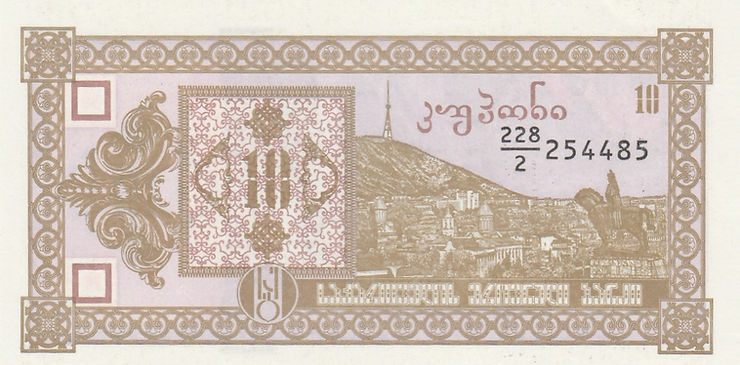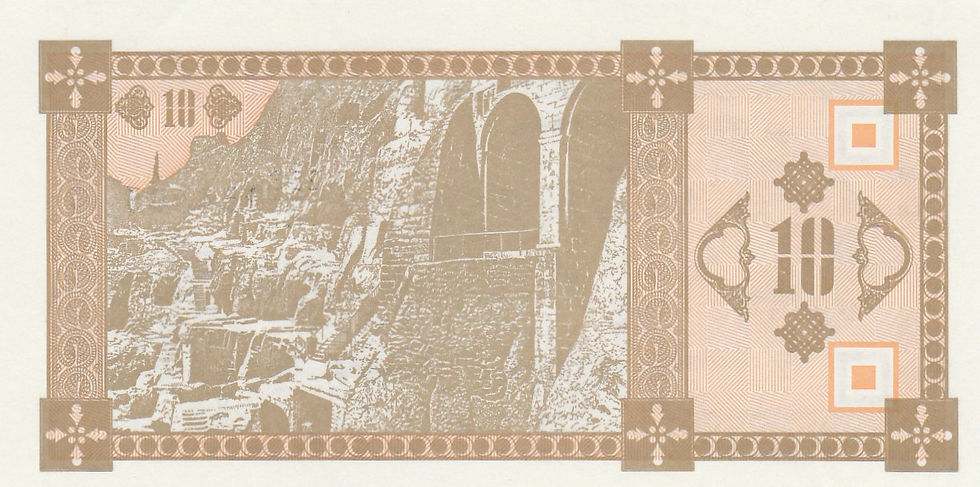This early post-Soviet Georgian banknote represents the 4th denomination of 2nd Issue Kuponi (1993). The Georgian Kuponi, also colloquially known as coupon notes or coupon money. Were a transitional currency, which served as an intermediary between the Soviet Ruble and Georgian Lari.
The Kuponi lacked sub-divisions and underwent rapid hyperinflation. It featured 4 different “Issues” (series) for 1993 alone, along with a single 1994 issue. While notes from the 4th Issue 1993/1994 have a unique appearance from previous issues. They continued to use same alternating color scheme used by previous issues.
Notably 1st Issue used a bounding 5 and 10 sequence (5, 10, 50, 100, etc.), that formed a rough basis for the first 3 Issues. The following 2nd Issue supplemented the lower denominations. While the 3rd Issue supplemented the higher denominations. Both of these Issues overlapped into the 1st Issue, forming a larger series. In contrast to the revised 4th Issue 1993/1994.
Observe

The observe features a sky view of Old Tbilisi, Mount Mtatsminda can be seen in background. Old Tbilisi forms the cultural capital of the Georgian people. Since King David IV of Georgia (1073-1125) moved the capital from Kutaisi, in 1122 CE. This act lead to the unification of the Kingdom of Georgia, leading to the period known as the Georgian Golden Age.
The note's observe draws heavily from this period, in it's artwork. The ornate frame resembles artwork seen in Georgian monasteries and churches. Toward the center left is an ornate "10", in the same art style. This is reinforced by the Georgian text (კუპონი) and number "10" at the upper right. When read together it simply translates to "10 Kuponi".
The text at the lower right (სებ საქართველოს ეროვნული ბანკი), translates to "NBG National Bank of Georgia". Notably the note's serial number (228/2 254485) has some subtle importance. The number "2" below the faction (/) marks the note as a being from the 2nd Issue. This number will match with the note's issue and can be used for easy identification.
Finally to the far left, we can see a pair of framed "boxes". These boxes form a negative for a registration element. They can be inspected by passing the note over a bight light.
Reverse

The reverse depicts the cave monastery of Vardzia, on the slopes of Mount Erusheti. The caves house the Church of Dormition, which dates to the 1180s. During the golden era of Queen Tamar the Great (1160-1213 CE). The site was mostly abandoned in the 16th century, due to the expanding influence of the Ottoman Turks.
Returning to the note, we can see the reverse features an ornate frame. This frame differs from the observe, it features a cross at every joint. Notably this is done to resemble the stone work seen in Georgian churches. Just as the observe the reverse features number "1"s. Located at the upper left and the far right. Also located at the far right are "boxes", representing the positive of a registration element.
2nd Issue Kuponi Gallery
(Gallery features all 2nd Issue Kuponi banknotes)
Additional Notes
This notes dimensions are 105 x 53 mm or 4.13 x 2.09 in, smaller than a standard US dollar.
Georgia was one of the first former Soviet Republics to adopt it's own currency.
The Georgian Kuponi has some similarities to the Lithuanian Talonas, in regards to purpose.
The cave monastery of Vardzia is a Georgian state heritage site and has been nominated as a UNESCO World Heritage Site.


























Comentarios